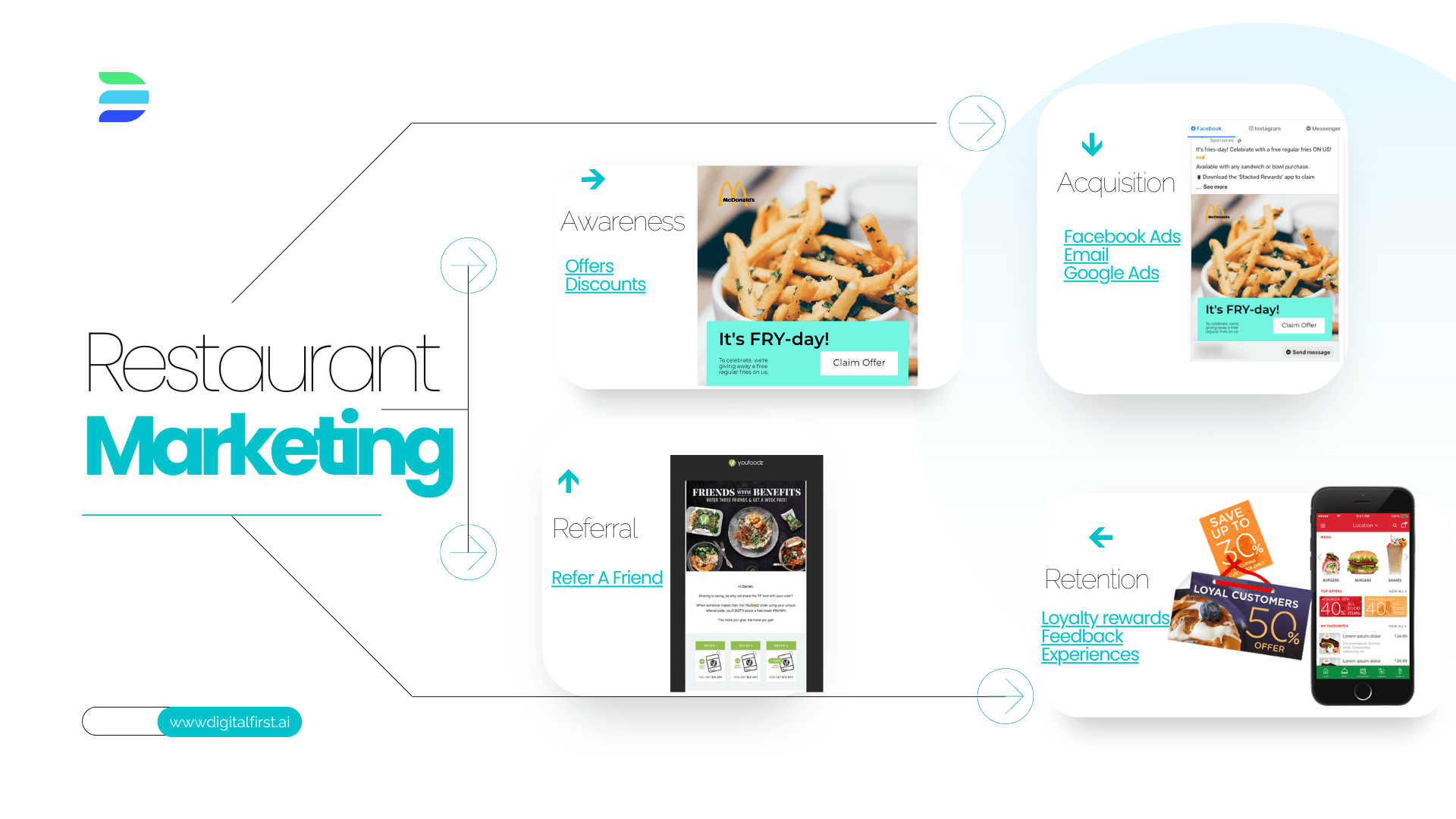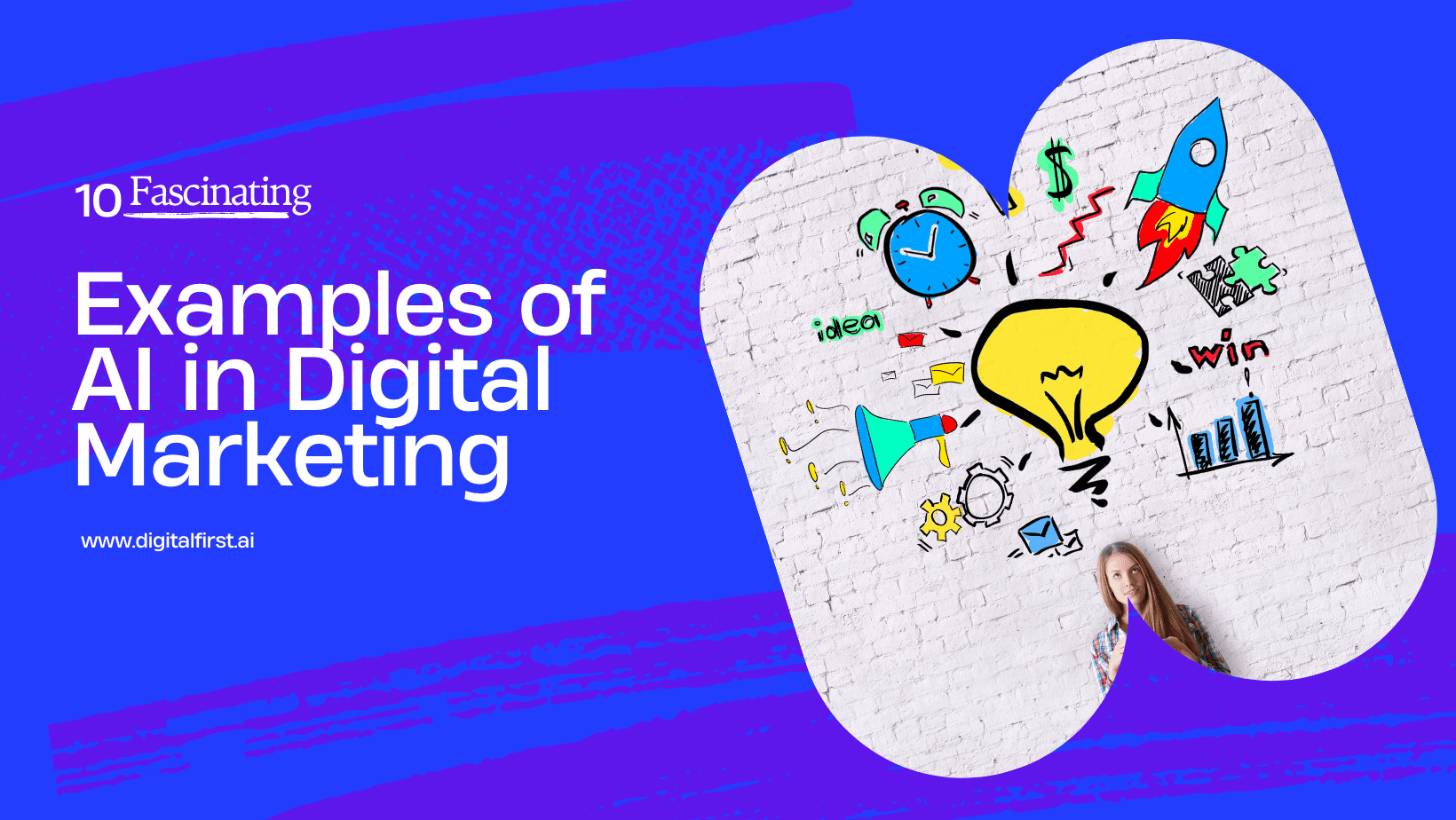Restaurant Marketing With A Twist: AI Generated Experience
If you’re a marketer or a restaurant owner, you'll be surprised at how easy it is for an AI to design your next restaurant marketing campaign
Sonu kalwar
Share:
I eat out a lot. You probably do too, but I think that's okay. I've had some great experiences with restaurants over the last couple of years, and have become a dedicated customer at many of my favorites. From the way the staff greets me upon entering to how they handle my request for extra pickles, I get more and more impressed by each visit.
My only complaint? The marketing for those restaurants isn't there where I need it -- when I'm sitting at home trying to figure out what and where to eat tonight.
If you’re a marketer or a restaurant owner, you'll be surprised at how easy it is for an AI to design your next restaurant marketing campaign. In just a few minutes, I'll walk through the process of building a special offer campaign, writing copies, designing creatives in minutes with the help of Digital First AI. In this guide, I'll walk you through:
How To Build an ICP - Ideal Customer Profile?
How To Map The Customer Journey/Create a Funnel?
How To Design & Execute The Campaign With DF AI?
Important Metrics
Try Digital First AI's Plug & Play AI-Powered Marketing Workflows Builder

No credit card needed. Instant access. Try now for free.
Build ICP - Ideal Customer Profile
Your target customer is the consumer you want to attract and keep as a patron. It's important to know who this person is, because knowing their demographics, lifestyle and pain points will help you tailor your marketing efforts toward them.
Additionally, you will want to create a specific type of customer profile for each location of your business. You may need different marketing strategies for a location in an urban area with lots of young professionals than you would for one in a rural community that caters mostly to families with school-age children.
Understand your current customer base.
Know what motivates them to visit your restaurant.
Know what they like about your restaurant.
Know what they don't like about your restaurant.
Demographics
Age
How old are your typical customers? Knowing this will help you determine what kinds of messaging and advertising to use. For example, if most of your customers are young adults, you could use social media platforms like Snapchat and Instagram instead of traditional channels such as radio or TV.
On the other hand, if your customer base skews older, it may make sense for you to focus on traditional advertising vehicles that reach older audiences.
Gender
Are more men or women eating at your restaurant? Knowing this can help shape the type of marketing materials you create and where they appear. If men make up a large percentage of your customer base (say 60%), then focusing primarily on sports teams in local newspapers might be a good idea; however, if women outnumber men by 2:1 (or more), then gender-specific offers are probably in order—for example “ladies night” discounts or special offers targeting only women would be appropriate here.
Personal Interests
Personal interests are another great place to start when creating a customer profile. Do you want to know what sports they like, what music they listen to, and what movies they watch? You can use this information to help you find even more ways of connecting with your customers.
If you're not sure where to start with the personal interests section of your customer profile, here are some ideas:
Are they an avid sports fan? Do they follow any specific teams or athletes? If so, see if there is any way that you can tie their favorite team into your restaurant's brand or marketing materials.
For example, if someone likes the Dallas Cowboys and always stops in for lunch while watching football games at home on Sundays—maybe offer a free appetizer during those games! That'll make them feel special and encourage them come back again later in the week!
What kind of music do they like listening too (or better yet: dancing too)? Maybe offer up some free tickets for a local concert once every couple months—that way everyone benefits from having more business at the restaurant while still being able to have fun!
Shopping Habits
How often do they shop?
Where do they shop?
What kind of products do they buy?
How much do they spend on average? (Use this as a benchmark to understand where to position your product.)
How many times do they visit a store in a month or year, and what was the last time they were in the store.
Purchase History
The next step is to take a look at your customer's purchase history. The more times someone orders from you, the more likely they are to come back again. Knowing what customers order and whether they eat in or order food to go can help you create a profile that will help you appeal to them better.
You'll want to find out if there are any patterns when it comes to the frequency of visits, as well as what kinds of foods they like best. You can also make note of which items have been selling well lately—this will help guide you in selecting new menu items for next season!
For example: Let's say Mary has been visiting my restaurant twice a month for the past three months and always orders her favorite dish—spaghetti bolognese with extra parmesan cheese on top (we don't serve this anymore).
She never brings anyone with her but always sits at table #9 because she likes how close it is both doors so she doesn't feel trapped by other people should she need an emergency exit route.)
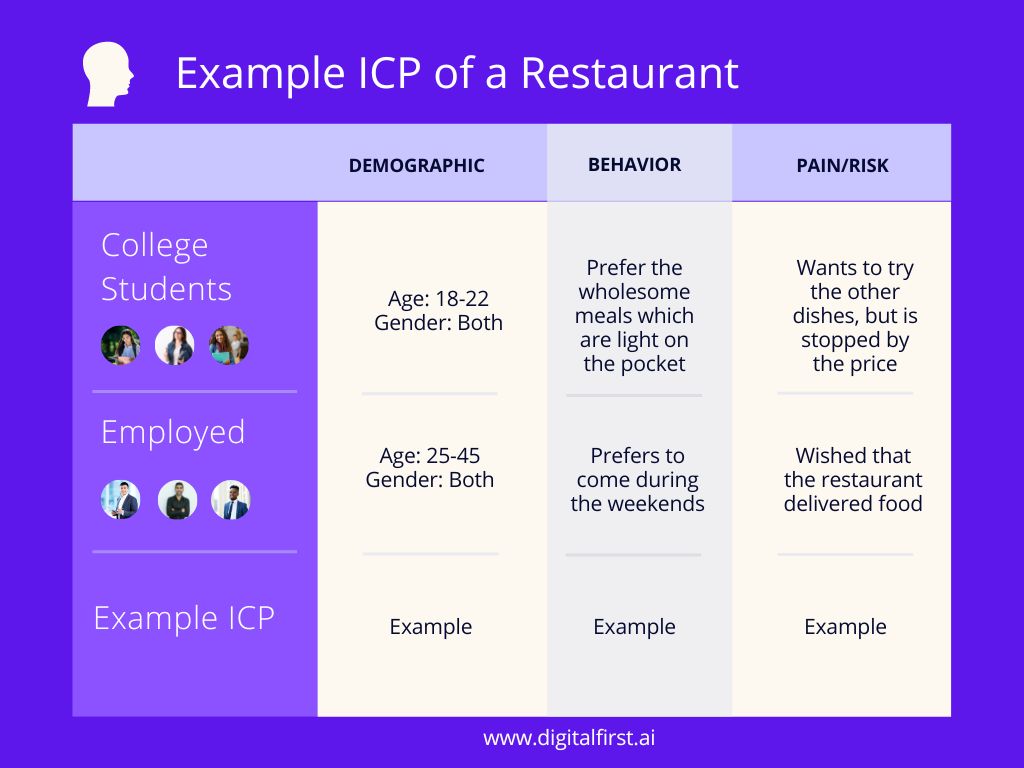
Customer Journey Mapping
Customer journey mapping is the art of analyzing a user’s touch points, perception of your company and its evolution. If you take a simple and candid approach to this useful technique, you can also expect to see your marketing strategy and operational activities improve at an accelerated rate.
Gartner predicts that by 2022, 90% of companies will compete mostly on customer experience.
According to Augie Ray, VP Analyst at Gartner “A journey map that focuses merely on the purchase funnel, and not the entire end-to-end customer journey, is not a CX journey map,” continued Ray. “Those sorts of journey maps may assist with efforts to build awareness, inbound traffic and acquisition, but they cannot uncover the opportunities that influence customer satisfaction, loyalty and long-term advocacy.”
Awareness - How/whom are you designing offers For?
Free fries with sandwich - Students
Discount on takeout orders - Working Professionals/Employee
All you can eat dishes" offer - Students
Give back to the community (like through charity events) - Working Professionals/Employee
BOGO (buy one get one) - Both
Acquisition - How are you distributing/promoting your offers?
Paid ads
Organic
Communities
Landing pages etc
Retention - Are your customers continuing to engage with the service?
Good Food/Experiences
Automated Feedbacks
Loyalty/Rewards Programs
Drip Emails
Referral - Are they referring your service to their friends/family?
Refer-a-Friend Programs
Word-of-Mouth
Awareness - How/whom are you designing offers For?
Offers are more important than ever before. They are the first thing that customers see and the last thing they remember, so it's important to make sure they're attractive and clear.
Offers have to be relevant to your customers and easy for them to understand. They should also be consistent across all channels (website, email marketing, social media etc.)
The way you design your offers can also help increase click-through rates from email marketing campaigns as well as conversion rates on websites or in a store.
Free Fries With Sandwich
The idea behind this strategy is that people who are hungry will be more likely to purchase a meal from a restaurant if they know they will receive something free with it. It's similar to how McDonald's gives away free food toys alongside their kids meals, or how gas stations give away free popcorn when you make a gas purchase.
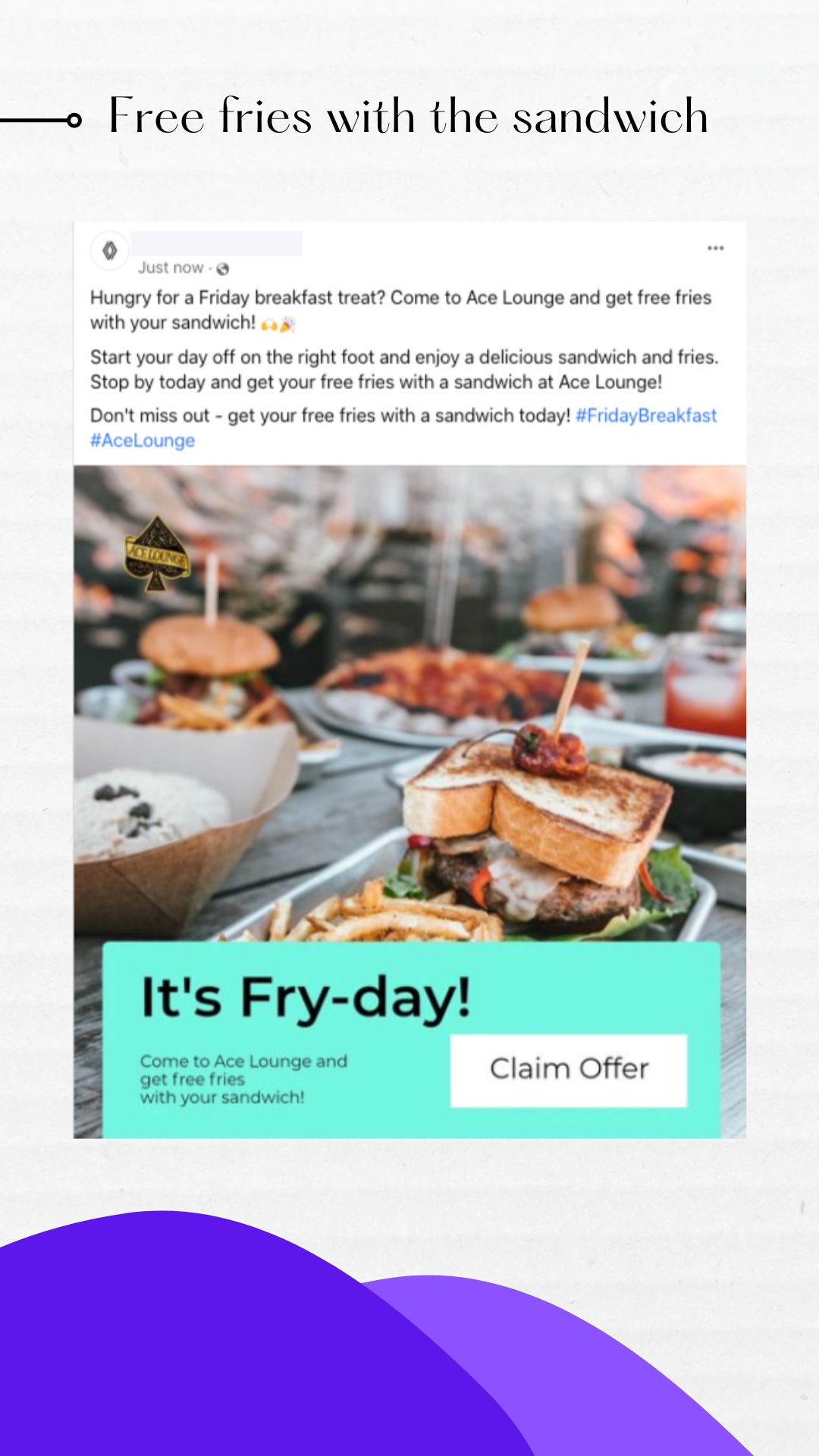
Design & copy generated with Digital First AI
Discount On Takeout Orders
A restaurant should offer a discount on takeout orders. This is an excellent option for those who live alone or have busy schedules. If possible, have the server ask if they would like to order takeout when they are checking out or even before they sit down at their table. This can make them feel like their time is valued and will increase the chance of them coming back again in the future.
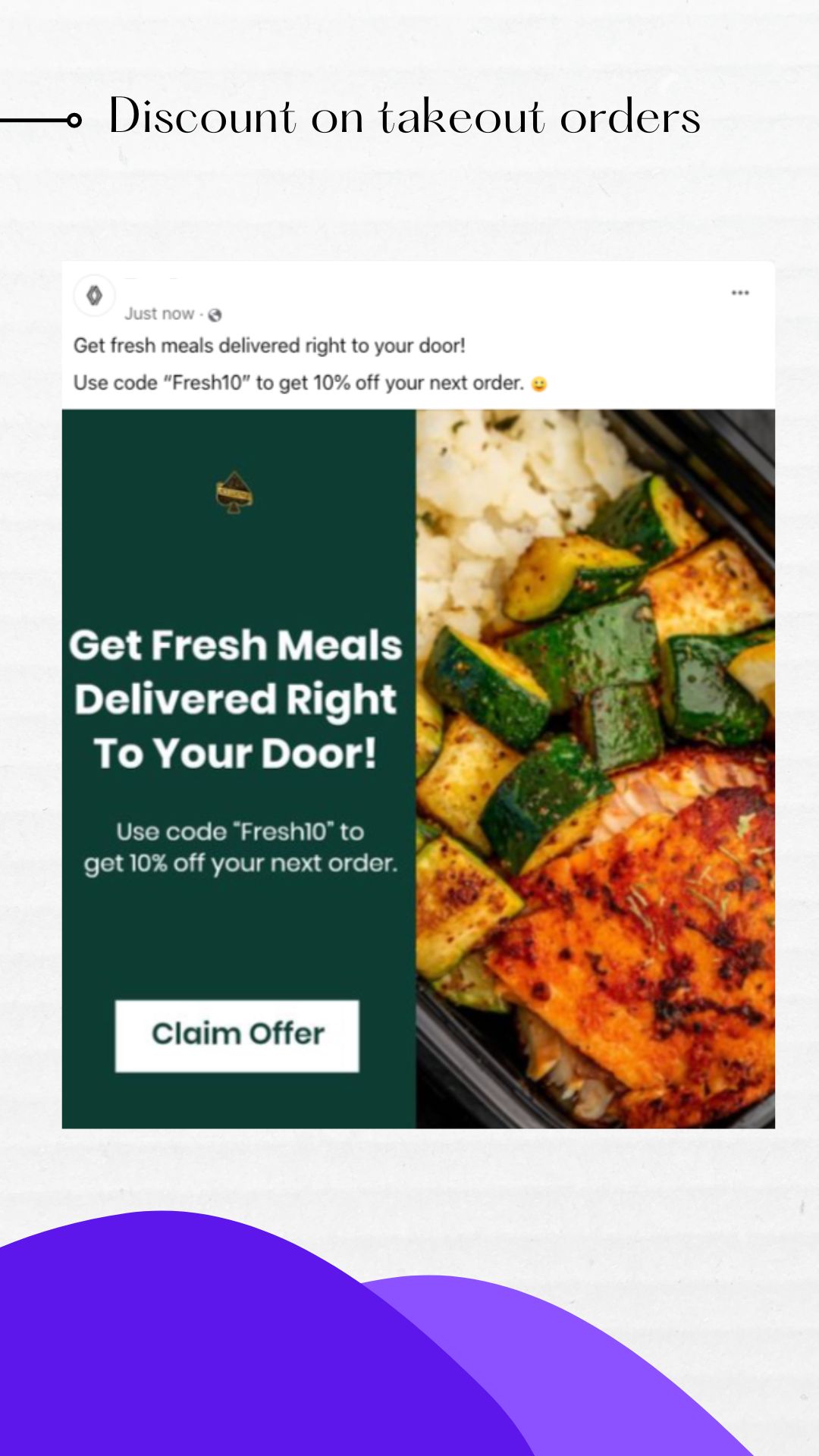
Design & copy generated with Digital First AI
"All You Can Eat Dishes" Offer
The "all you can eat" offer is a great way to attract customers who want to try out your menu without having to pay for each dish. It's perfect for the customer who wants a variety of food or doesn't know what they want.
The key to making this work is knowing how much food you really need to prepare, which will depend on how many people you expect and how much they'll eat. The higher the volume, the better—but don't go overboard! It's also important that whatever you're serving is fresh and tasty so that customers are satisfied with their experience.
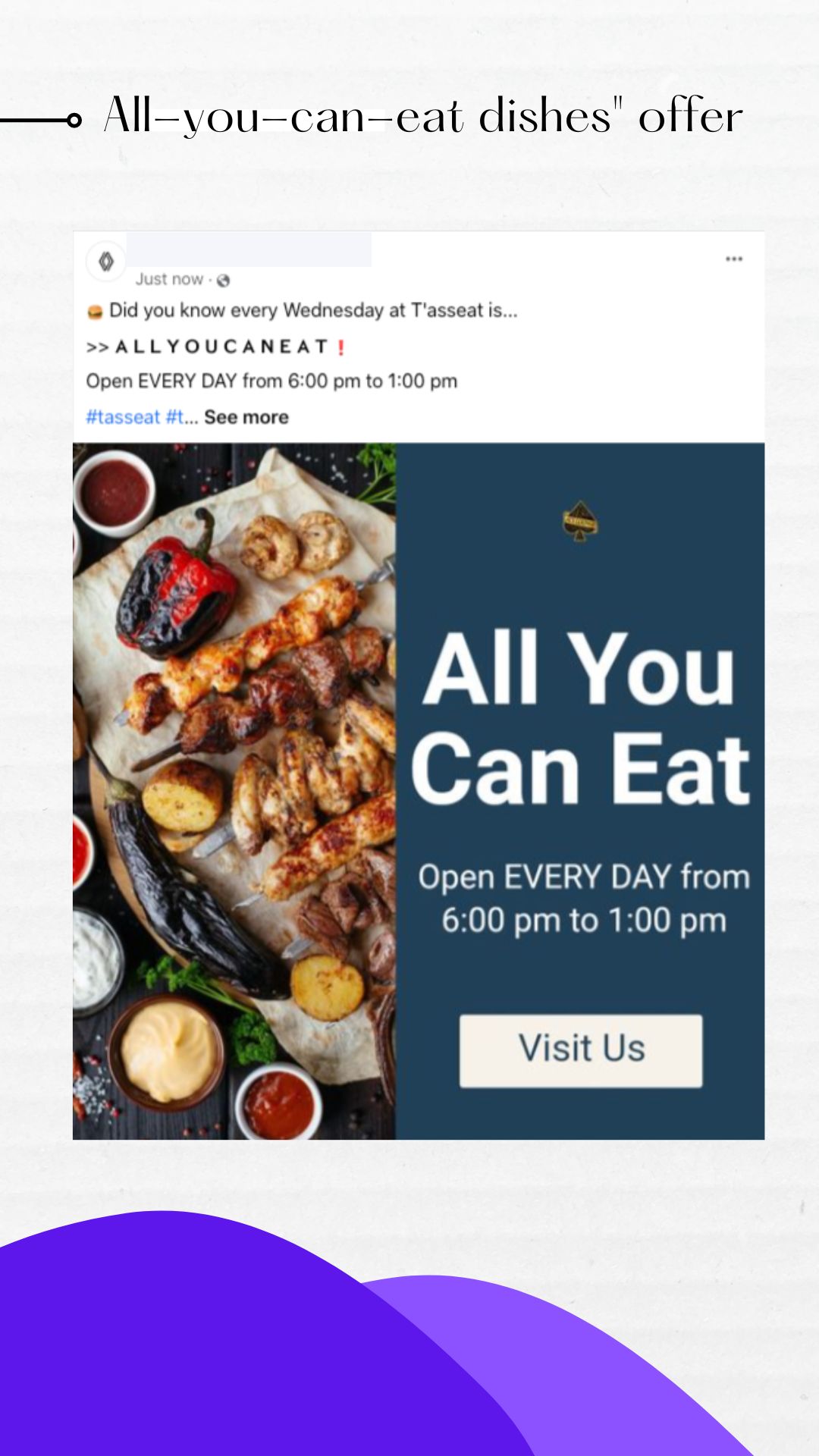
Give Back To The Community
Giving back to the community is a great way to make your restaurant stand out. If you’re not sure where to start, consider sponsoring a local charity event or donating food, money or time.
Charity events are fun and effective ways to connect with customers in your area. When they see that you’re giving back, they’ll be more likely to come into your restaurant for dinner or lunch (and maybe even help you sell tickets for next year!

Design & copy generated with Digital First AI
BOGO (Buy One Get One)
Buy one, get one. This is one of the most common and simple offers you can make to customers. You offer a discount for customers who buy two or more items, regardless of whether it's food and drink or just one or the other.
BOGO can be used in different ways: for example you might offer a BOGO on all drinks between 7pm and 8pm every Friday night. Or you could offer different deals on different days of the week - offering a BOGO on drinks from 4pm-6pm during the week but only at weekends; or vice versa!
It’s important that your staff know how best to explain this offer - especially when someone orders two menu items at once, like a burger & fries - so they don't give away too much information about what your business does!

Design & copy generated with Digital First AI
Acquisition - How Are You Promoting Your Offers?
Pay Per Click (PPC)
Pay per click (PPC) is the most popular form of digital marketing. PPC ads are shown on search engines, social media platforms, and other websites in order to drive customers to your business. When someone searches for a restaurant or food-related keyword on Google, Facebook and Instagram it’s possible that your ad will show up at the top of their search results.
This means that you only pay for clicks on these ads—not views or impressions like with traditional advertising channels. This makes them much more cost effective so you can get a lot more bang for your buck!
Read this article that explains more about advertising funnel with examples.
Social Media Marketing
Social media is a great way to promote your restaurant and build a following. It's also an opportunity to interact with customers, increase brand awareness, and drive traffic to your website.
Facebook is the most popular social network. You can use Facebook advertising to target people who live within 25 miles of your restaurant or who have booked tables at restaurants similar to yours in the past month.
A successful campaign will increase customer engagement and online reservations as well as drive traffic to your website through social media posts that link back to your homepage.
Here's a thirteen-step process that will help you create an effective social media marketing strategy for your business in just 30 minutes or less!
Guest Reviews and Bookings Via Social Media
Social Media is a great way to get customer reviews. The guest review process can happen very quickly, and it’s important to listen and respond because the customer may be looking for more than just an apology.
Social media is also a useful tool for restaurants because it allows them to reach out to new customers. A restaurant can use social media platforms such as Facebook and Instagram in order to promote their products or services, which would increase the amount of traffic they receive on a daily basis.
Email Marketing
Email marketing is a great way to stay in touch with your customers. You can send them special offers, birthday wishes, and more. You can also communicate with them about the latest news and events.
You can also use it to send out surveys and feedback.
SEO (Search Engine Optimization)
SEO (Search Engine Optimization) is the process of improving the visibility of a website in organic search engine results. It is important for restaurants because it is free, it works, and it is easy to implement. SEO is not a quick fix; rather it's something that should be done systematically over time.
It's also worth mentioning that some people have misconceptions about SEO such as "my menu isn't that descriptive" or "I don't serve any exotic dishes." This doesn't matter when you're looking at how Google sees your restaurant. The content on your website will determine its relevance in search results, not how many times you include the word "pizza" in its description.
Website Development and Design
Make sure your website is mobile-friendly. According to the Pew Research Center, almost half of Americans own a smartphone and nearly three-quarters own a tablet or e-reader. If your site is not optimized for mobile devices, it will be difficult for customers to navigate and find what they are looking for.
Make sure it's easy to navigate. Your website or landing page should be an extension of your restaurant’s brand – clean, clear and easy-to-use so that customers can find what they need quickly and easily.
This includes having a good search engine on your website as well as offering directions so that people can get there easily if they don’t know where to go right off the bat! If someone spends too much time trying to figure out how everything works on their first visit then chances are high that this customer won't return again soon thereafter!
Guest Communication via Text Messaging and Mobile Apps
As a restaurant owner, you may have noticed that text messaging is becoming a popular way for customers to connect with businesses. A text message service like Textlocal allows you to send messages directly from your phone or computer and track how many people open the message and click through on links. This can help you measure the effectiveness of your texts, which makes it easier to decide what kinds of promotions are working best.
Another option is using an app developed specifically for restaurants, such as Slice's OrderAhead app or Eat24's waitlist feature. These apps allow customers to order food in advance of their arrival so their order is ready when they come in; this reduces wait times at the register and increases customer satisfaction.
The best part? You don't even need an actual menu—with some basic information about what kind of food you serve and how many people are coming into your restaurant (which many apps ask), guests can place orders from their phones before ever stepping foot inside!
Retention - Are Your Customers Continuing To Engage With The Service?
Loyalty Programs
Despite the fact that we all daydream of a restaurant where you can sit down and order whatever you want without having to worry about your bill increasing by 20% because you're a "loyal customer" or not being able to get a reservation for brunch because it's first come first serve unless of course you're a "loyal customer", loyalty programs are still an effective way to retain customers.
There are many different kinds of loyalty programs out there. Some restaurants have point systems where every dollar spent results in one point towards free food or drinks from their menu (e.g., Starbucks Rewards), whereas other restaurants offer special prices for people who have been coming regularly for some time (e.g., Baskin Robbins).
If your restaurant has its own unique rewards scheme then make sure it is communicated clearly on your website and other marketing materials so that people know what they can expect if they choose to become loyal customers!
Rewards
If not using some kind of points system then another great way to reward loyal customers would be through offering them special deals or discounts just for coming back again and again! For example if someone orders five meals within two weeks at one particular branch of Pizza Hut then they could receive 50% off their next meal there too! You could also do this with drinks too; let's say someone buys two beverages over three visits in two weeks: well now they get 25% off all future purchases!
Referrals - Are They Referring Your Service To Their Friends/Family?
Make it easy for customers to recommend their favorite restaurant
No matter how great your food and service are, if you don't have a marketing strategy in place to help you get the word out about your restaurant, no one will ever know about it.
Here's how you can make it easy for customers to recommend their favorite restaurant:
Make sure that they have a way of sharing their experience with friends and family on social media sites like Facebook, Twitter, and Pinterest. If they can't find an easy way to share their experience with others via social media, then there's really no point in having these accounts set up at all—or even bothering with any sort of digital marketing strategy in the first place!
Use Digital First AI to Design & Execute The Campaign
Digital First AI is a revolutionary marketing tool that will transform the way you think about marketing. From funnel management, content creation, and marketing strategies to team collaboration. All your marketing needs are in one place. Here’s how you can use it to design & execute your marketing campaign.
Step 1: Use Pre-Made Marketing Funnel For Restaurant
Use our pre-made templates for your next marketing campaign and let us do the work for you. Think of how much time and money you’ll save with our AI platform.
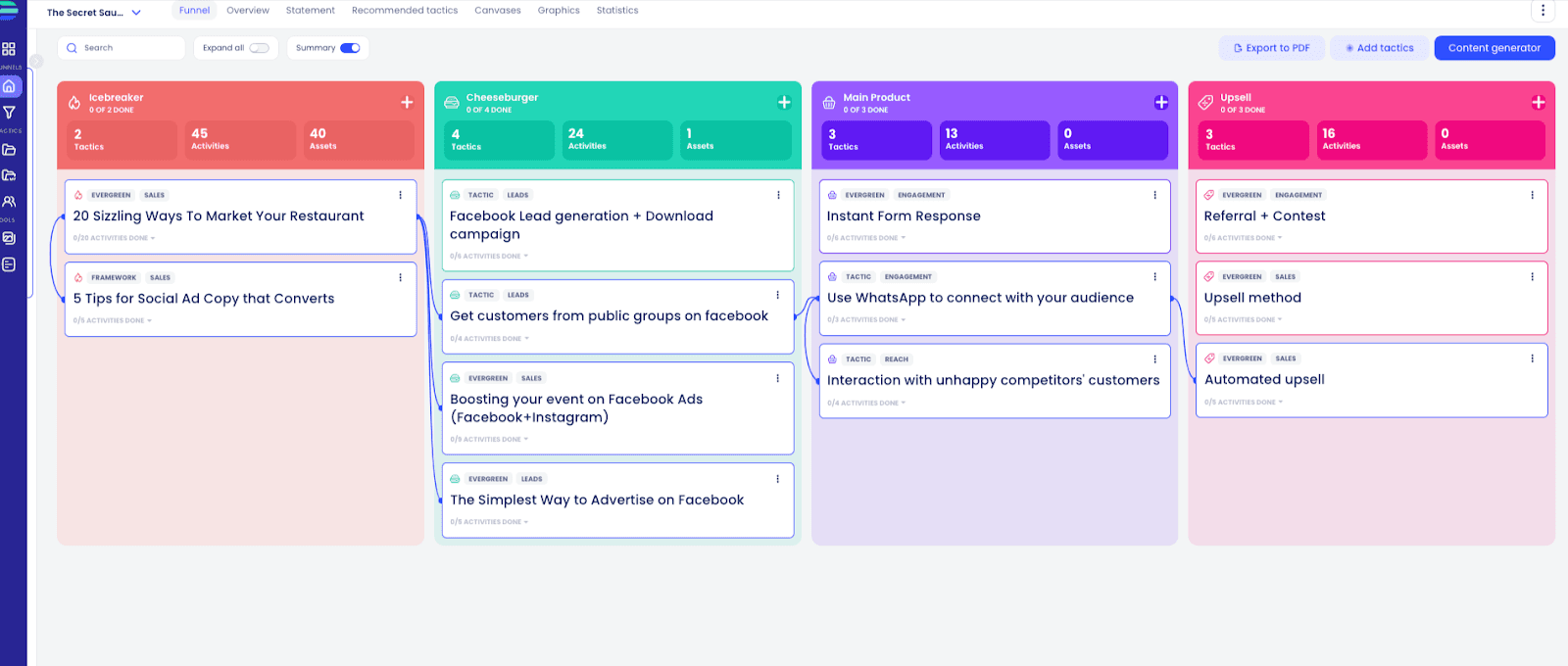
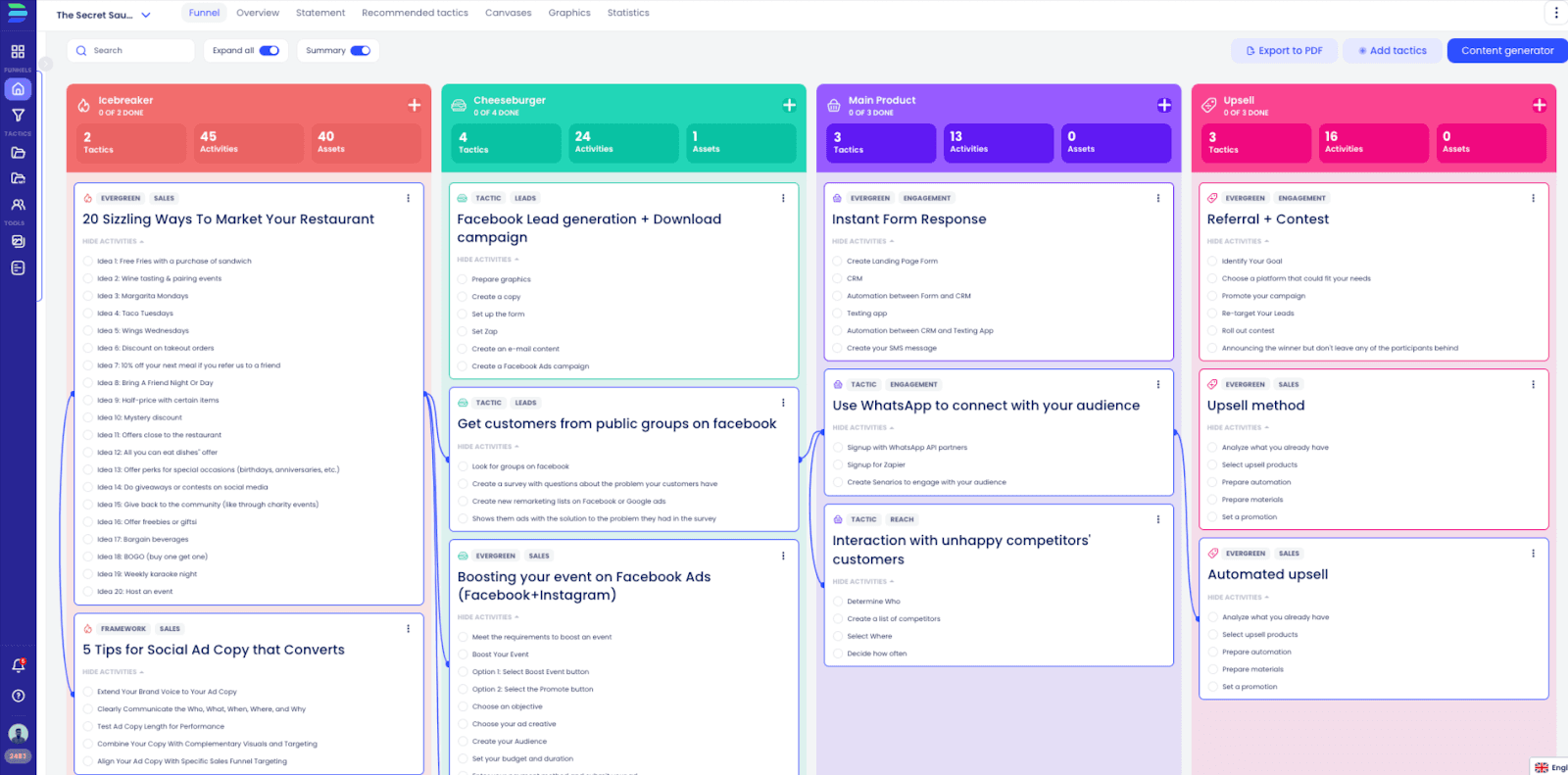
Step 2: Use Digital First AI To Create Copies Automatically
Get the most out of your content with Digital First AI. This automated content generator makes it easy to write engaging, on-brand and fully optimized content for all parts of your funnel—from lead magnets to social media posts and beyond. Create content in 25 different languages, from short but-packed sentences to longer blog posts and even e-books.
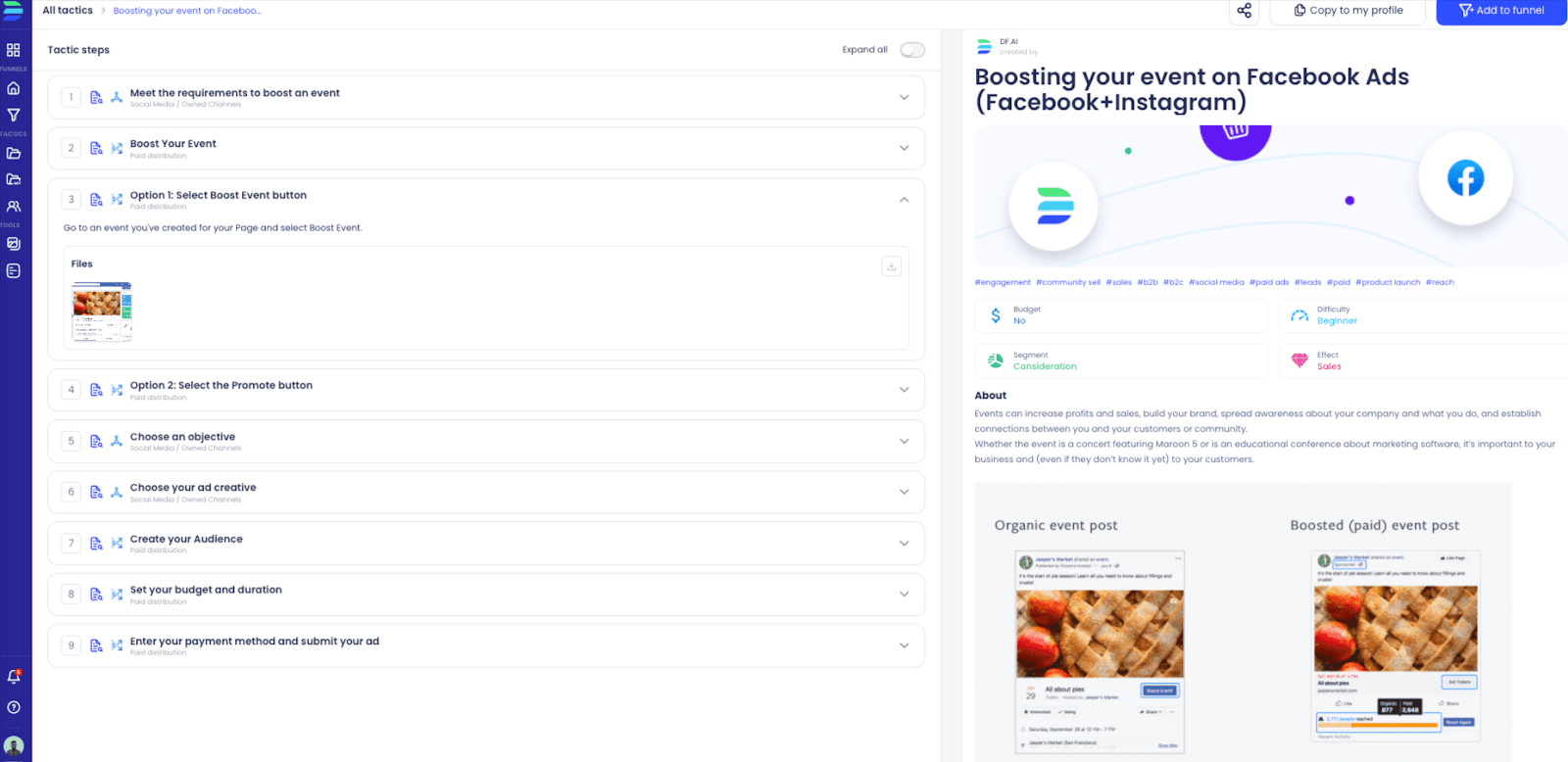
Marketing Metrics Every Restaurant Should Track
If you're a restaurant owner, it's important to keep track of your revenue and key digital metrics. You can use this data to identify which marketing channels are performing well for you and which ones need some adjustments. If you want to know how well your restaurant is doing financially, here are five marketing metrics that every food business needs to measure:
Revenue Metrics
You can't just look at the numbers and see how well your restaurant is doing. That's why it's important to understand what these metrics mean and use them to figure out if your business is growing or shrinking, what trends are happening, and more.
Revenue: Your total revenue for a given period of time (month, year)
Average check: The average amount spent per customer visit (or by all customers during that period)
Average ticket: The average price of each transaction (for example, an appetizer + main dish + dessert might cost $30; thus the average ticket is $15)
Ticket/customer ratio: This shows whether people are ordering higher-priced items or lots of small ones; this should be considered when designing menus or deciding on pricing strategies
Marketing Metrics
When you launch a marketing campaign, it’s important to keep track of the metrics that matter. When you look at your website analytics, are people visiting your site? Are they clicking on your ads? Are they subscribing to your newsletter? How many people are downloading your app and sharing content on social media?
The most important metric to track is how often people come back after visiting or doing business with a business once. Did they return because their last experience was excellent? Was it so bad that they will never darken the door again (and tell all their friends about how horrible it was)?
A good way of tracking this is by using customer satisfaction surveys. These surveys can be automated through an app like SurveyMonkey which makes it easy for customers who come into contact with any aspect of a company's service -- from buying products online through emailing customer service representatives -- to provide feedback about whether or not they were satisfied with their experience overall as well as point out any problems they might've encountered along the way (such as receiving faulty goods).
Social Media Metrics
Social media can be used in many ways to effectively market your restaurant. The most basic use is to promote special events, such as a wine tasting or happy hour. You can also use social media to provide customer service, engage with customers and promote the restaurant's brand.
Website Metrics
Bounce rate: Your bounce rate is the percentage of visitors who leave your site after viewing only one page. This metric is important because it shows how well you're converting visitors into customers (or leads). If the majority of people who visit your website leave immediately, that means they weren't interested in what you had to say or sell.
A low bounce rate can indicate that people are finding what they want on your site and sticking around—which is more likely if you've got a lot of content on each page, leading them down an organic path as they move through different areas of the site.
If a visitor bounces quickly after landing on a specific page, it might mean that something about that particular piece doesn't resonate with them or its copy isn't compelling enough to make them stay longer than 5 seconds—in which case it's probably time for some rethinking!
Conversion Rate: Conversion rates measure how many conversions occur per x amount of traffic directed toward your site over y period of time (i.e., 1 conversion per 1000 visits) expressed as a percentage.
Build Marketing Workflows That Work for you

No credit card needed. Instant access. Try now for free
Digital First AI empowers marketers with AI-driven tools to centralize data, build personalized strategies, and execute campaigns seamlessly.
Generate content, automate workflows, and outpace competitors—all in one secure platform.
AI-Powered Data Room: Centralize and analyze unstructured data for actionable insights.
AI Strategy Canvases: Generate 26+ strategic canvases for tailored campaigns.
Advanced Research Tools: Conduct real-time market and competitor research.
AI Content & Visuals: Create high-quality copy and visuals with leading AI models.
Drag-and-Drop Workflow Builder: Design and automate custom workflows effortlessly.
Pre-Built Templates: Jumpstart campaigns with customizable templates.
Over 15,000 marketers and entrepreneurs from around the world are already reaping the benefits. Enjoy a free trial without any commitments!
It’s a Wrap
I’ve covered a lot in this post, but you can see how having a framework will help you build a strong foundation for your restaurant marketing campaigns. If this is an area where you struggle, I recommend trying out Digital First AI. Our AI marketing platform will be able to guide you through all the steps of creating your marketing funnel by providing expert advice and recommendations from start to finish.

